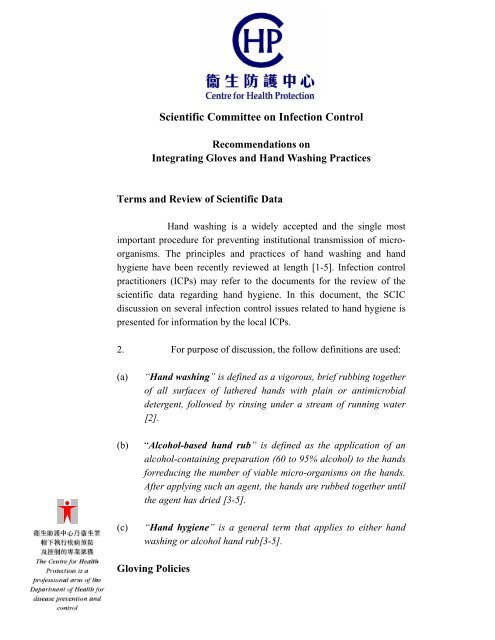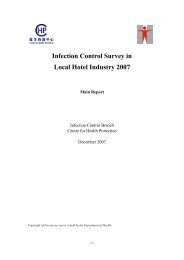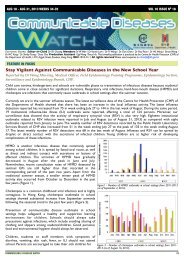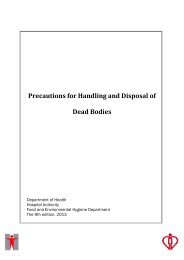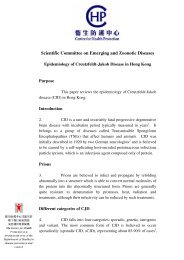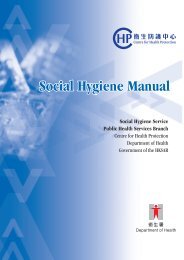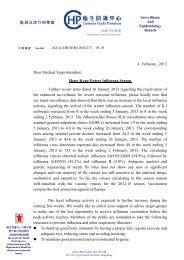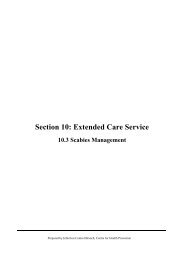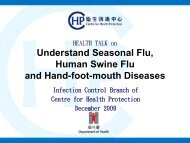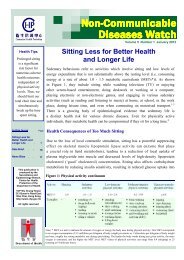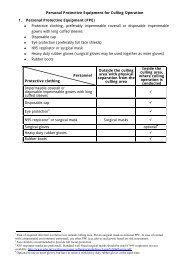Integrating Gloves and Hand Washing Practices
Integrating Gloves and Hand Washing Practices
Integrating Gloves and Hand Washing Practices
You also want an ePaper? Increase the reach of your titles
YUMPU automatically turns print PDFs into web optimized ePapers that Google loves.
Scientific Committee on Infection Control<br />
Recommendations on<br />
<strong>Integrating</strong> <strong>Gloves</strong> <strong>and</strong> H<strong>and</strong> <strong>Washing</strong> <strong>Practices</strong><br />
Terms <strong>and</strong> Review of Scientific Data<br />
H<strong>and</strong> washing is a widely accepted <strong>and</strong> the single most<br />
important procedure for preventing institutional transmission of microorganisms.<br />
The principles <strong>and</strong> practices of h<strong>and</strong> washing <strong>and</strong> h<strong>and</strong><br />
hygiene have been recently reviewed at length [1-5]. Infection control<br />
practitioners (ICPs) may refer to the documents for the review of the<br />
scientific data regarding h<strong>and</strong> hygiene. In this document, the SCIC<br />
discussion on several infection control issues related to h<strong>and</strong> hygiene is<br />
presented for information by the local ICPs.<br />
2. For purpose of discussion, the follow definitions are used:<br />
(a) “H<strong>and</strong> washing” is defined as a vigorous, brief rubbing together<br />
of all surfaces of lathered h<strong>and</strong>s with plain or antimicrobial<br />
detergent, followed by rinsing under a stream of running water<br />
[2].<br />
(b) “Alcohol-based h<strong>and</strong> rub” is defined as the application of an<br />
alcohol-containing preparation (60 to 95% alcohol) to the h<strong>and</strong>s<br />
forreducing the number of viable micro-organisms on the h<strong>and</strong>s.<br />
After applying such an agent, the h<strong>and</strong>s are rubbed together until<br />
the agent has dried [3-5].<br />
(c) “H<strong>and</strong> hygiene” is a general term that applies to either h<strong>and</strong><br />
washing or alcohol h<strong>and</strong> rub[3-5].<br />
Gloving Policies
3. Healthcare workers (HCWs) wear gloves to 1) reduce the risk of<br />
personnel acquiring infections from patients, 2) prevent health-care worker<br />
flora from being transmitted to patients, <strong>and</strong> 3) reduce contamination of the<br />
h<strong>and</strong>s of personnel by flora that can be transmitted from one patient to another.<br />
This shouldn’t be translated to mean that HCWs should wear gloves “all the<br />
time” in patient areas for the following reasons:<br />
(a) The fallacy of wearing gloves “all the time” is based on the idea that a<br />
glove offers better protection than our own skin for infectious material.<br />
This is not true, if any defects on the skin are already protected by the<br />
proper dressing. The sensation in our skin would alert us to any contact<br />
with secretions or fluids (which has the most infectious hazards) <strong>and</strong><br />
they can then be immediately removed by a good h<strong>and</strong> wash. The gloves<br />
on the other h<strong>and</strong> would make one oblivious to such a contact <strong>and</strong><br />
subsequently further contamination of our working environment would<br />
inevitably ensue. Consequently, the potentials for infectious<br />
transmission by indirect contact means will increase. Therefore in<br />
infection control, gloves are only worn for obnoxious procedures or<br />
those with excessively gross contamination. Under such circumstances,<br />
gloves use is important, because h<strong>and</strong> hygiene may not remove all<br />
potential pathogens when h<strong>and</strong>s are heavily contaminated [6].<br />
(b) The proper use of gloves requires some judgments. As is the case for<br />
most medical decision, the HCWs will need to take into considerations<br />
factors such as the nature of the procedures, type of activity, the duration<br />
of contact, the status of patient, the nature of the pathogens involved,<br />
<strong>and</strong> the clinical settings. In principle, gloves are strongly recommended<br />
for anticipated contacts with blood, body fluid, secretion, excretions,<br />
mucous membrane <strong>and</strong> non-intact skin. Examples of such kind include<br />
sputum suction, taking nasopharyngeal aspirate, changing napkin,<br />
h<strong>and</strong>ling of urinals <strong>and</strong> bedpans. Indiscriminate use of gloves (i.e. “all<br />
the time”) removes the value-added “professional judgment” which<br />
characterized the health care workers.<br />
(c) Several studies have found that misuse of gloves may expose patients to<br />
increased risk for infections [7-9]. Gloving “all the time” easily gives<br />
the worker a false sense of security. When gloves become a “second”<br />
skin, they become a vehicle for transmission of microorganisms from<br />
dirty to clean areas in the same patient <strong>and</strong> the environment, <strong>and</strong> from<br />
one to another patient. In this regard, improper <strong>and</strong> excessive gloving<br />
were found to decrease h<strong>and</strong> hygiene frequencies [7;9;10]. According to<br />
Girou et al, the improper use of gloves was associated with personnel<br />
missing more than half of the opportunities for h<strong>and</strong> hygiene [7]. In the<br />
study by Thompson et al, gloves were appropriately changed in only<br />
16% of instances [10].<br />
2
(d) Regular use of glove contributes to skin problems <strong>and</strong> latex allergies<br />
[11]. In highly exposed groups, it may even increase the occurrence of<br />
certain serious IgE-mediated reactions. This subject was recently<br />
reviewed [12].<br />
(e) Alcohol-based h<strong>and</strong> rub solutions are designed <strong>and</strong> evaluated for<br />
application on the h<strong>and</strong>s <strong>and</strong> not on gloves [3, 22-23]. There is no need<br />
to apply alcohol-based solution to “disinfect” unused gloves, which are<br />
sufficiently “clean” for infection control purposes. Actually, alcohol rub<br />
solutions will harden the latex <strong>and</strong> thus loosening out the integrity <strong>and</strong><br />
the gloves may become not protective from glove micro-leaks [27]. The<br />
same pair of used gloves should not be used between patients or move<br />
from “dirty” to “clean” body sites in the same patient. Used <strong>and</strong> dirty<br />
gloves should be removed. Worn gloves should not be washed or<br />
disinfect with alcohol-based solutions <strong>and</strong> reuse [14]. Failure to remove<br />
gloves after “patient contact” or between “dirty” <strong>and</strong> “clean” body-site<br />
care on the same patient is an instance of nonadherence to st<strong>and</strong>ard<br />
h<strong>and</strong>-hygiene recommendations [3, 26].<br />
4. For the above reasons, the SCIC has the following<br />
recommendation:<br />
There is evidence that the improper use of gloves is a hazard to patients.<br />
Institutions <strong>and</strong> infection control practitioners are suggested to take measure<br />
to monitor <strong>and</strong> to promote the proper <strong>and</strong> judicious use of gloves for isolation<br />
precautions.<br />
Gloving <strong>and</strong> H<strong>and</strong> <strong>Washing</strong><br />
5. Gloving doesn’t remove the need for h<strong>and</strong> washing. Following<br />
removal of gloves, alcohol-based h<strong>and</strong> rub is normally NOT a substitute for<br />
h<strong>and</strong> washing. The rationale is as follows:<br />
(a) H<strong>and</strong>s can be contaminated even when gloves are used, <strong>and</strong> are easily<br />
contaminated in the process of removing gloves [13]. Following<br />
removal of gloves, studies have shown that h<strong>and</strong>s are commonly<br />
contaminated by nosocomial pathogens such as methicillin-resistant<br />
Staphylococcus aureus (MRSA) with rates of up to 50% [14]. Despite<br />
attention to how gloves were removed, occult breaks in unused latex<br />
gloves can cause substantial contamination of the h<strong>and</strong>s [15]. It should<br />
be pointed out that the tests approved by the U.S. Food <strong>and</strong> Drug<br />
Administration for assessment of the barrier quality of gloves includes<br />
visual inspection <strong>and</strong> a water leak test; neither methods directly evaluate<br />
ability of gloves to prevent penetration by bacteria <strong>and</strong> virus. According<br />
to Korniewicz et al, 20% of latex gloves which had passed the<br />
watertight test allowed penetration of bacteria to the h<strong>and</strong>s [16]. After<br />
use in clinical settings, studies found that glove leaks were frequent<br />
3
(42.6 <strong>and</strong> 8.5% <strong>and</strong> for vinyl <strong>and</strong> latex gloves respectively) <strong>and</strong> that<br />
most health care workers failed to report awareness of the presence of<br />
glove leaks which were subsequently demonstrated [13].<br />
(b) Powdered latex gloves are the most common type of gloves available for<br />
use in health care settings. On the application of alcohol h<strong>and</strong> rub, the<br />
cornstarch powder intended to facilitate donning forms agglutinates.<br />
Besides discomfort, the donning powder may compromise the antiseptic<br />
efficacy of alcohol h<strong>and</strong> rub. At present, the latter issue has not been<br />
adequately evaluated from a scientific point of view.<br />
(c) Despite gloving, soiling of the h<strong>and</strong>s by organic material may occur<br />
when gloves are worn for dirty patient care procedures (e.g. sputum<br />
suction, h<strong>and</strong>ling excreta, changing napkin). The readers are suggested<br />
to refer to the Fulkerson’s scale [17] for further information on types of<br />
contacts that are “dirty.” In presence of soiling, alcohol-based h<strong>and</strong> rub<br />
is less effective. Furthermore, alcohol-based h<strong>and</strong> rub (the same is true<br />
for all h<strong>and</strong> antiseptics) is poorly active against Clostridium difficile<br />
spores [18] that may be present in the feces of 10% or more of<br />
hospitalized patients [19]. Under such circumstances, the physical action<br />
of washing <strong>and</strong> rinsing for removal of bacterial spores is important. As<br />
Clostridium difficile infections emerge [20], h<strong>and</strong> washing assumes even<br />
more important roles for their prevention.<br />
6. For the above reasons, the SCIC has the following<br />
recommendation:<br />
H<strong>and</strong> washing should be practised after removal of gloves. H<strong>and</strong> washing<br />
but not alcohol-based h<strong>and</strong> rubs is the preferred method for h<strong>and</strong> hygiene<br />
after removal of gloves.<br />
H<strong>and</strong> <strong>Washing</strong> Versus Alcohol H<strong>and</strong> Rub<br />
7. The indications for h<strong>and</strong> hygiene <strong>and</strong> the proper h<strong>and</strong> hygiene<br />
techniques have been recently reviewed [3-5]. In choosing between h<strong>and</strong><br />
washing <strong>and</strong> alcohol h<strong>and</strong> rub, the following rules serve as references:<br />
(a) H<strong>and</strong> washing <strong>and</strong> alcohol-based h<strong>and</strong> rub only gives the desired effect<br />
if each h<strong>and</strong> hygiene action is properly performed [17]. Alcohol-based<br />
h<strong>and</strong> rub requires good technique to apply the agent to all parts of h<strong>and</strong>s.<br />
Recently, Widmer et al found that antimicrobial effectiveness of<br />
alcohol-based h<strong>and</strong> rub was strongly influenced by techniques <strong>and</strong><br />
recommended that special training be provided before the alcohol-based<br />
h<strong>and</strong> rub was used as a substitute for h<strong>and</strong> washing [21].<br />
(b) If h<strong>and</strong>s are visibly soiled (including visibly dirty or when you feel that<br />
it is dirty) or potentially contaminated with proteinaceous material, then<br />
4
h<strong>and</strong> washing should be practised. Under such circumstances, waterless<br />
alcohol-based h<strong>and</strong> rub is NOT a substitute for h<strong>and</strong> washing.<br />
(c) If h<strong>and</strong>s are not dirty or visibly contaminated, an alcohol-based h<strong>and</strong> rub<br />
is an acceptable substitute for h<strong>and</strong> washing during routine patient care<br />
activities. In this regard, alcohol-based h<strong>and</strong> rub is at least as effective as<br />
st<strong>and</strong>ard h<strong>and</strong> washing in two r<strong>and</strong>omized clinical trials [22;23].<br />
Contact Precautions <strong>and</strong> Routinely Wearing <strong>Gloves</strong> when Entering<br />
the Room<br />
8. The CDC guideline on contact precautions suggests health care<br />
workers to “wear gloves when entering the room” as a Category IB<br />
recommendation [24]. For patients who are isolated in single rooms, this<br />
approach is practical <strong>and</strong> may have merits. The same approach, when applied<br />
indiscriminately to other settings such as when multiple patients are cohorted in<br />
the same cubicle or in the same open ward (i.e. gloving when entering ward),<br />
may be problematic.<br />
9. Personnel will likely wear gloves continuously <strong>and</strong> use glove as<br />
their “second skin” <strong>and</strong> may not change gloves between patients. Several<br />
reports as well as local experience have underlined the risk of h<strong>and</strong>-gloved<br />
personnel moving from patient to patient without glove change <strong>and</strong> h<strong>and</strong><br />
hygiene [7;9;10]. In a long-term care facility, Thompson reported that gloves<br />
were changed appropriately in only 16% [10]. In an observational study of<br />
glove use in a teaching hospital, the continued use of gloves without removal<br />
resulted in 64% of all contacts being performed without adequate h<strong>and</strong> hygiene<br />
[7]. The study further found that poor compliance with gloves change was the<br />
only independently significant risk factor for h<strong>and</strong> hygiene non-compliance.<br />
This leads Girou et al [7] to conclude that “achieving the goal of a high<br />
compliance to h<strong>and</strong> hygiene in our (their) facility is unlikely to be reached<br />
unless a profound adjustment of gloving practices occurs.”<br />
10. As reviewed recently by Larson et al, many studies have shown a<br />
relation between improved h<strong>and</strong>-hygiene practices <strong>and</strong> reduced infection rates<br />
[25]. Hence, high compliance in h<strong>and</strong> hygiene practices has been a central issue<br />
in infection control for decades. However, the impact of gloving on h<strong>and</strong><br />
hygiene compliance has not been firmly established, because published studies<br />
have yielded mixed results. “Wearing gloves” has been identified as a risk<br />
factor for poor adherence to recommended h<strong>and</strong> hygiene practices [26]. If h<strong>and</strong><br />
hygiene is not monitored, “routinely wearing gloves” may have the opposite<br />
effect in isolation precautions.<br />
11. As mentioned in the CDC 2004 DRAFT “Guideline for isolation<br />
precautions” document, no studies have directly compared st<strong>and</strong>ard precautions<br />
alone <strong>and</strong> st<strong>and</strong>ard precautions plus contact precautions for prevention of<br />
5
multiresistant organisms. In preventing transmission by the contact means, the<br />
efficacy of “routinely gloving” in contact precautions as compared to “gloving<br />
when indicated according to the type of anticipated exposure” plus good h<strong>and</strong><br />
hygiene is unknown.<br />
12. In Hong Kong, only a small number of patients who require<br />
contact precautions may be put in single rooms. Priority should be given to the<br />
patients with conditions that may facilitate transmission (e.g. tracheostomy,<br />
fecal incontinence, extensive skin lesions, <strong>and</strong> multiple draining wounds). For<br />
most patients, it is likely that a “cohort” approach in a multi-cubicle ward will<br />
continue to be used. Under such circumstances, “gloving” routinely on entering<br />
a cubicle or a ward <strong>and</strong> wearing gloves for every patient contact (<strong>and</strong> requiring<br />
h<strong>and</strong> washing after each glove removal) may be neither practical nor beneficial.<br />
13. Recent experience from a few local hospital outbreaks of<br />
respiratory <strong>and</strong> gastrointestinal infections indicates that inadequate h<strong>and</strong><br />
washing facilities in some units constitutes an important barrier for good<br />
infection control practices.<br />
14. Since alcohol-based h<strong>and</strong> rub can decontaminate the h<strong>and</strong>s<br />
effectively as long as there is no soiling <strong>and</strong> can be easily accessible, this<br />
committee opt that not requiring “routine gloving” for “clean” contact (such as<br />
those defined by the Fulkerson scale [17]) with patients placed on contact<br />
precautions in multi-patient rooms or cubicle is acceptable <strong>and</strong> preferred. In a<br />
ward where multiple patients with the same diagnosis are placed together under<br />
contact precautions, this committee discourages the indiscriminate wearing of<br />
gloves “on entering the ward” <strong>and</strong> also for ward activities that do not involve<br />
direct patient contact (e.g. using telephone, typing computer keyboards, writing<br />
case notes, touching door h<strong>and</strong>les). However, measures should be taken by the<br />
infection control officer to ensure that personnel comply with proper h<strong>and</strong><br />
hygiene practices [3-5] <strong>and</strong> that alcohol-based h<strong>and</strong> rubs do not inappropriately<br />
substitute some m<strong>and</strong>atory h<strong>and</strong> washing indications [17]. <strong>Gloves</strong> should also<br />
be worn when they are indicated according to the anticipated exposures.<br />
15. For the above rationale, the SCIC has the following<br />
recommendation on this issue:<br />
(a) <strong>Gloves</strong> should not be worn routinely on entry to areas such as a<br />
cubicle or a ward where multiple patients with the same infection are<br />
placed together for contact precautions. Instead, gloves should only be<br />
worn for “dirty” patient care procedures <strong>and</strong> when clinically indicated.<br />
For patients who require contact precautions, ICPs should take<br />
measures to ensure a high compliance to good h<strong>and</strong> hygiene practices.<br />
(b) In areas where transmission of microorganisms by the contact means<br />
is a concern, improving h<strong>and</strong> hygiene adherence including the<br />
6
provision of administrative support <strong>and</strong> resources should be an<br />
institutional priority. The SCIC recommends that h<strong>and</strong> washing<br />
facilities should be sufficient (approximately 1 h<strong>and</strong> washing facility<br />
for every 5 to 6 patient beds in multi-patient areas), accessible <strong>and</strong><br />
easily available.<br />
Centre for Health Protection<br />
28 January 2005<br />
The copyright of this paper belongs to the Centre for Health Protection, Department of Health, Hong<br />
Kong Special Administrative Region. Contents of the paper may be freely quoted for educational,<br />
training <strong>and</strong> non-commercial uses provided that acknowledgement be made to the Centre for Health<br />
Protection, Department of Health, Hong Kong Special Administrative Region. No part of this paper<br />
may be used, modified or reproduced for purposes other than those stated above without prior<br />
permission obtained from the Centre.<br />
7
Reference List<br />
1. Larson EL. APIC guideline for h<strong>and</strong>washing <strong>and</strong> h<strong>and</strong> antisepsis in health<br />
care settings. Am J Infect Control 1995; 23(4):251-269.<br />
2. Garner JS, Favero MS. CDC guidelines for the prevention <strong>and</strong> control of<br />
nosocomial infections. Guideline for h<strong>and</strong>washing <strong>and</strong> hospital<br />
environmental control, 1985. Supersedes guideline for hospital<br />
environmental control published in 1981. Am J Infect Control 1986;<br />
14(3):110-129.<br />
3. Boyce JM, Pittet D. Guideline for H<strong>and</strong> Hygiene in Health-Care Settings.<br />
Recommendations of the Healthcare Infection Control <strong>Practices</strong> Advisory<br />
Committee <strong>and</strong> the HICPAC/SHEA/APIC/IDSA H<strong>and</strong> Hygiene Task Force.<br />
Society for Healthcare Epidemiology of America/Association for<br />
Professionals in Infection Control/Infectious Diseases Society of America.<br />
MMWR Recomm Rep 2002; 51(RR-16):1-45, quiz.<br />
4. Boyce JM, Pittet D. Guideline for H<strong>and</strong> Hygiene in Health-Care Settings.<br />
Recommendations of the Healthcare Infection Control <strong>Practices</strong> Advisory<br />
Committee <strong>and</strong> the HIPAC/SHEA/APIC/IDSA H<strong>and</strong> Hygiene Task Force.<br />
Am J Infect Control 2002; 30(8):S1-46.<br />
5. Boyce JM, Pittet D. Guideline for H<strong>and</strong> Hygiene in Health-Care Settings:<br />
recommendations of the Healthcare Infection Control <strong>Practices</strong> Advisory<br />
Committee <strong>and</strong> the HICPAC/SHEA/APIC/IDSA H<strong>and</strong> Hygiene Task Force.<br />
Infect Control Hosp Epidemiol 2002; 23(12 Suppl):S3-40.<br />
6. Kjolen H, Andersen BM. H<strong>and</strong>washing <strong>and</strong> disinfection of heavily<br />
contaminated h<strong>and</strong>s--effective or ineffective? J Hosp Infect 1992; 21(1):61-<br />
71.<br />
7. Girou E, Chai SH, Oppein F, Legr<strong>and</strong> P, Ducellier D, Cizeau F, Brun-<br />
Buisson C. Misuse of gloves: the foundation for poor compliance with h<strong>and</strong><br />
hygiene <strong>and</strong> potential for microbial transmission? J Hosp Infect 2004;<br />
57(2):162-169.<br />
8. Patterson JE, Vecchio J, Pantelick EL, Farrel P, Mazon D, Zervos MJ,<br />
Hierholzer WJ, Jr. Association of contaminated gloves with transmission of<br />
Acinetobacter calcoaceticus var. anitratus in an intensive care unit. Am J<br />
Med 1991; 91(5):479-483.<br />
9. Yap FH, Gomersall CD, Fung KS, Ho PL, Ho OM, Lam PK, Lam DT,<br />
Lyon DJ, Joynt GM. Increase in methicillin-resistant Staphylococcus aureus<br />
acquisition rate <strong>and</strong> change in pathogen pattern associated with an outbreak<br />
of severe acute respiratory syndrome. Clin Infect Dis 2004; 39(4):511-516.<br />
8
10. Thompson BL, Dwyer DM, Ussery XT, Denman S, Vacek P, Schwartz B.<br />
H<strong>and</strong>washing <strong>and</strong> glove use in a long-term-care facility. Infect Control<br />
Hosp Epidemiol 1997; 18(2):97-103.<br />
11. Bubak ME, Reed CE, Fransway AF, Yunginger JW, Jones RT, Carlson CA,<br />
Hunt LW. Allergic reactions to latex among health-care workers. Mayo<br />
Clin Proc 1992; 67(11):1075-1079.<br />
12. Sussman GL, Beezhold DH, Liss G. Latex allergy: historical perspective.<br />
Methods 2002; 27(1):3-9.<br />
13. Olsen RJ, Lynch P, Coyle MB, Cummings J, Bokete T, Stamm WE.<br />
Examination gloves as barriers to h<strong>and</strong> contamination in clinical practice.<br />
JAMA 1993; 270(3):350-353.<br />
14. Doebbeling BN, Pfaller MA, Houston AK, Wenzel RP. Removal of<br />
nosocomial pathogens from the contaminated glove. Implications for glove<br />
reuse <strong>and</strong> h<strong>and</strong>washing. Ann Intern Med 1988; 109(5):394-398.<br />
15. Muto CA, Sistrom MG, Strain BA, Farr BM. Glove leakage rates as a<br />
function of latex content <strong>and</strong> br<strong>and</strong>: caveat emptor. Arch Surg 2000;<br />
135(8):982-985.<br />
16. Korniewicz DM, Laughon BE, Butz A, Larson E. Integrity of vinyl <strong>and</strong><br />
latex procedure gloves. Nurs Res 1989; 38(3):144-146.<br />
17. Rotter ML. H<strong>and</strong> washing <strong>and</strong> h<strong>and</strong> disinfection. In: Mayhall C.G., editor.<br />
Hospital Epidemiology <strong>and</strong> Infection Control. 2004: 1727-1746.<br />
18. McDonnell G, Russell AD. Antiseptics <strong>and</strong> disinfectants: activity, action,<br />
<strong>and</strong> resistance. Clin Microbiol Rev 1999; 12(1):147-179.<br />
19. Hutin Y, Casin I, Lesprit P, Welker Y, Decazes JM, Lagrange P, Modai J,<br />
Molina JM. Prevalence of <strong>and</strong> risk factors for Clostridium difficile<br />
colonization at admission to an infectious diseases ward. Clin Infect Dis<br />
1997; 24(5):920-924.<br />
20. Valiquette L, Low DE, Pepin J, McGeer A. Clostridium difficile infection<br />
in hospitals: a brewing storm. CMAJ 2004; 171(1):27-29.<br />
21. Widmer AE, Dangel M. Alcohol-based h<strong>and</strong>rub: evaluation of technique<br />
<strong>and</strong> microbiological efficacy with international infection control<br />
professionals. Infect Control Hosp Epidemiol 2004; 25(3):207-209.<br />
9
22. Zaragoza M, Salles M, Gomez J, Bayas JM, Trilla A. H<strong>and</strong>washing with<br />
soap or alcoholic solutions? A r<strong>and</strong>omized clinical trial of its effectiveness.<br />
Am J Infect Control 1999; 27(3):258-261.<br />
23. Girou E, Loyeau S, Legr<strong>and</strong> P, Oppein F, Brun-Buisson C. Efficacy of<br />
h<strong>and</strong>rubbing with alcohol based solution versus st<strong>and</strong>ard h<strong>and</strong>washing with<br />
antiseptic soap: r<strong>and</strong>omised clinical trial. BMJ 2002; 325(7360):362.<br />
24. Garner JS. Guideline for isolation precautions in hospitals. The Hospital<br />
Infection Control <strong>Practices</strong> Advisory Committee. Infect Control Hosp<br />
Epidemiol 1996; 17(1):53-80.<br />
25. Larson E. Skin hygiene <strong>and</strong> infection prevention: more of the same or<br />
different approaches? Clin Infect Dis 1999; 29(5):1287-1294.<br />
26. Pittet D, Boyce JM. H<strong>and</strong> hygiene <strong>and</strong> patient care: pursuing the<br />
Semmelweis legacy. Lancet Infect Dis 2001; 4:9-20.<br />
27. Mellstrom, G. A., M. Lindberg, <strong>and</strong> A. Boman. 1992. Permeation <strong>and</strong><br />
destructive effects of disinfectants on protective gloves. Contact Dermatitis<br />
26:163-170.<br />
10


